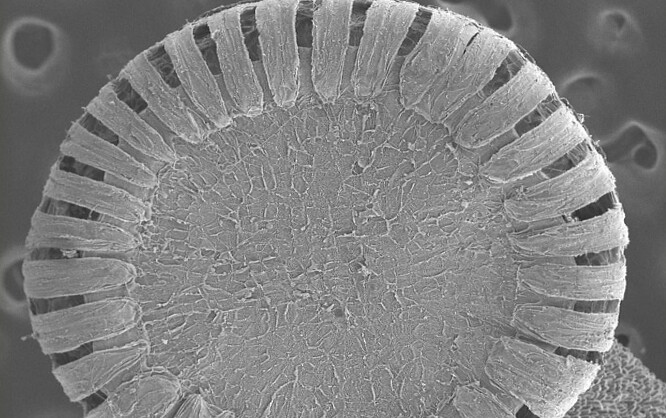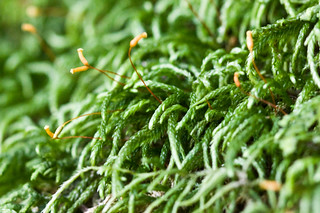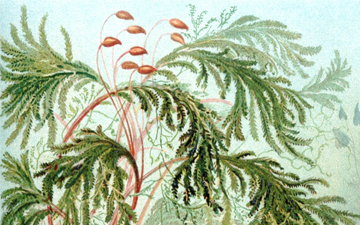Bryophyta

CONTORTED HAIRY CAP MOSS
Pogonatum contortum


Sorry, there is no photo available. If you have one, please submit
here
.
2 POINTS
Image Description: Scanning Electron Microscopy (SEM) image of the sporangium which has a pepper shaker mechanism for spore dispersal.
cool, warm
Graphic by Jennifer Deol & Diana W.
Plants medium-sized to large, in loose tufts or scattered, olive green to dark green. Stems 3-12 cm, erect, mostly simple. Leaves 5-9 mm, strongly crisped and contorted when dry, plane and broadly spreading when moist, loosely sheathing at base, linear-lanceolate, ending in a short spine; sheath not strongly differentiated, with gradually sloping shoulders, toothed nearly […] read more

FOUR-TOOTHED WONDER MOSS
Tetraphis pellucida


Sorry, there is no photo available. If you have one, please submit
here
.
2 POINTS
Image Description: Scanning electron microscopy (SEM) image of the sporangium, which has four teeth structures for dispersing spores.
cool, warm
Graphic by Shona Ellis
Tetraphis pellucida is one of two species ofmoss in the acrocarpous genus Tetraphis.[1] Its name refers to its four large peristome teeth found on the sporophyte capsule. Tetraphis pellucida occurs almost exclusively on rotten stumps and logs,[2] and is native to the northern hemisphere.[3] The leafy shoot is between eight and 15 mm tall. The lower […] read more

LANTERN MOSS
Andreaea nivalis


Sorry, there is no photo available. If you have one, please submit
here
.
3 POINTS
Image Description: Scanning electron microscopy (SEM) image of the lantern shaped spongium, which occurs during dry conditions – the optimal conditions for spore dispersal.
cold, cool, warm
Graphic by Jennifer Deol & Diana W
Andreaea is a genus of rock mossesdescribed as a genus in 1801.[1][2][3] They are small, delicate acrocarpous mosses (meaning that the capsules are formed at the tips of vertical branches) that form dark brown or reddish cushions on wet siliceous rocks in mountainous areas. The capsule lacks theperistome teeth and operculum of other mosses, and […] read more

Moss
Isothecium cristatum



2 POINTS
Fact: Like other mosses, Isothecium cristatum does not have flowers and seeds, but reproduces using spores and spore capsules.
cold, cool, warm, hot
Graphic by Victoria Heryetvictoriaheryet.com/
Photo by Image by: Ken-ichiwww.flickr.com/photos/ken-ichi/
Moss “Muscinae” from Ernst Haeckel‘s Kunstformen der Natur, 1904 Scientific classification Kingdom: Plantae Division: Bryophyta Schimp. Classes [2] Takakiopsida Sphagnopsida Andreaeopsida Andreaeobryopsida Oedipodiopsida Polytrichopsida Tetraphidopsida Bryopsida Mosses are small, soft plants that are typically 1–10 cm (0.4–4 in) tall, though some species are much larger. They commonly grow close together in clumps or mats in damp […] read more

Fox-tail Feather Moss
Thamnobryum alopecurum


Sorry, there is no photo available. If you have one, please submit
here
.
5 POINTS
• Thamnobryum alopecurum has a SPREAD of 1/2 (1 per 2 turns).
Cold, Cool
Graphic by Ernst Haeckelen.wikipedia.org/wiki/File:Haeckel_Muscinae.jpg
Thamnobryum is a genus of moss in family Neckeraceae. (From Wikipedia, May 23rd, 2010) read more